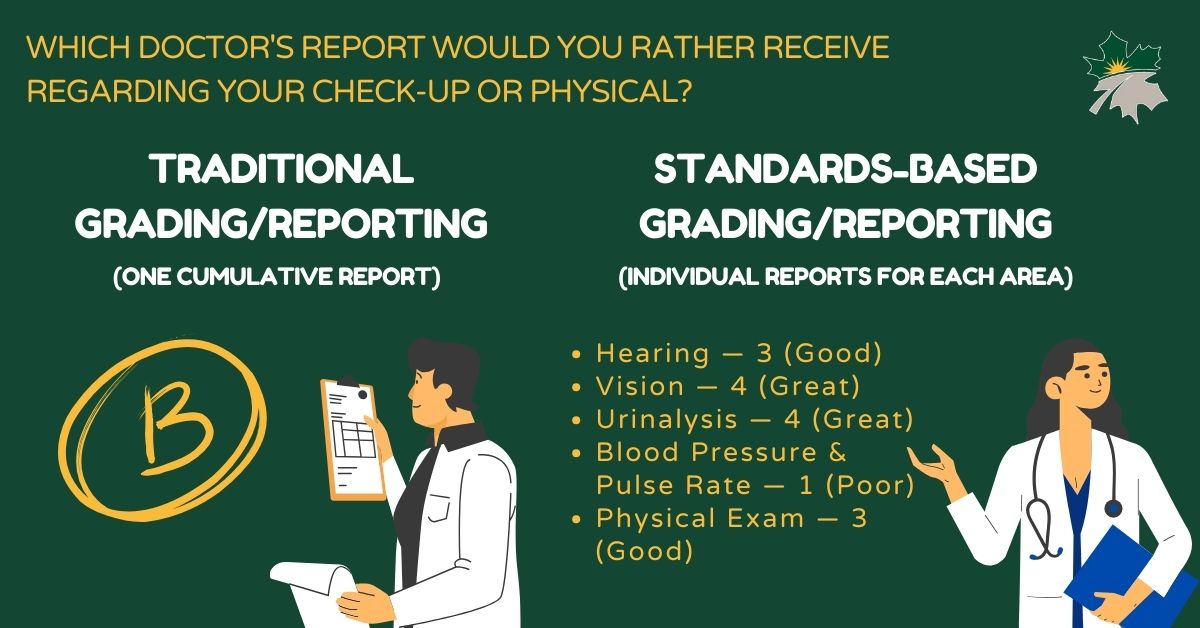Standards-Based Reporting

Welcome to an introduction of standards-based reporting. Standards-based practices have long been a part of our school's learning and teaching practices. We also use standards-based reporting to clearly communicate the growth our students are making throughout a school year. Standards-based refers to an approach to teaching, evaluating, grading, and communicating student progress. The standards are expectations set by the Illinois State Board of Education.
Select teachers in each of our district's five buildings have piloted standards-based reporting since 2022. A variety of resources can be found below regarding:
Our recommitment to teaching, learning, and assessing to the Illinois Learning Standards
Our process for assessing where a student is at a given moment, in time in relation to the standard, by utilizing a proficiency scale (rubric)
Our process for making sure our grades accurately reflect a student’s level of achievement with respect to a given priority standard
Our process for assessing non-academic attributes and dispositions that we feel are essential for students to be successful
The process our staff who are piloting a standards based reporting system are using to communicate with students and families
If you are a parent with questions, you are encouraged to contact your child’s classroom teacher or building principal.
Why the Standards-Based Approach?
We use standards-based reporting to clearly communicate the growth our students are making throughout the school year. In this approach:
Students show their understanding, knowledge, and skills identified by the standards.
The student’s progress is communicated to students and parents by identifying the student's progress on an identified standard.
This type of progress report replaces a letter grade on the report card. The standards-based report card will show a student's progress toward the specific grade-level standards.
Benefits of Standards-Based Approach
For Students
Learning targets are clearly defined and aligned with state standards.
Students are offered multiple opportunities and ways through which to demonstrate proficiency.
Students aren’t penalized for not understanding a skill at the beginning of instruction.
Students monitor their own progress toward the achievement of specific targets.
Specific feedback on progress helps build self-esteem, pride, and motivation for students.
Helps promote a culture of learning vs. earning, risk taking, and learning from mistakes.
For Parents
Report cards are clear and have more meaning.
More accurate representation of students learning and mastery of their learning.
Parents are aware of exactly what their child knows, and is able to do, and the next steps for progress.
Parents know in what areas their child needs more support.
Parents are empowered to increase their child’s confidence and help their student set goals.
For Teachers
Teachers know exactly where students stand in their progress towards learning targets and what support needs to be provided.
Aligned expectations and standards across grade levels in every subject.
Assessment results show teachers when students need extra help and when they need more challenging work.
Teachers are encouraged to find new ways to assess student learning. It’s not a one size fits all approach.


Additional Standards-Based Resources
Elementary Schools: Grading Visuals | LEAF Skills
Middle School: Grading Visuals | LEAF Skills
High School: Grading Visuals
Videos (slide 16): Students on standards-based learning
Proficiency scale samples: 5th Grade
BOE presentation (Nov. 2023): Standards-Based Reporting, Part II
BOE presentation (Oct. 2023): Standards-Based Reporting, Part I
Nov. 2023: Geneseo schools piloting standards-based reporting
BOE presentation (May 2023): Renewing a Standards-Based Approach to Education at Geneseo
Harvard Statement on Proficiency-Based Education & Graduation
